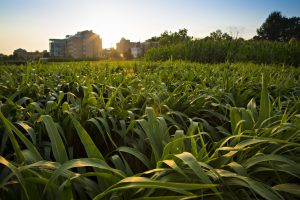The University of Missouri College of Agriculture, Food and Natural Resources (CAFNR) celebrated the 130th anniversary of Sanborn Field on Tuesday, July 24, on the MU campus.
There were discussions and presentations, as well as displays of historical equipment and photos, in Eckles Hall. There were tours of Sanborn Field, too.
Sanborn Field is the oldest, continuous experimental field west of the Mississippi River and the third oldest in the world.
“Not only was it the 130th anniversary of Sanborn Field, it was the 101st year of the Duley-Miller Erosion Plots and the 70th anniversary of the announcement of the discovery of the antibiotic Aureomycin at Sanborn,” said Tim Reinbott, assistant director of the Agricultural Experiment Station. “Sanborn Field is the oldest continuous experimental field west of the Mississippi River. Research from the Duley-Miller plots led to the establishment of what is now the USDA-NRCS. Aureomycin was used in animal and human disease prevention for decades and saved many lives.”

Sanborn Field was established in late 1888 by Dean J.W. Sanborn, who was looking to demonstrate the value of crop rotations and manure in grain crop production. Randy Miles, an associate professor emeritus of soil, environmental and atmospheric science, talked more about the history of Sanborn Field during the celebration. Miles also discussed the current research taking place at the site.
Other speakers included Clark Gantzer, professor emeritus, School of Natural Resources; Bob Kremer adjunct associate professor, Division of Plant Sciences and USDA-ARS; Newell Kitchen, adjunct associate professor, School of Natural Resources and USDA-ARS; Kristen Veum (adjunct assistant professor, School of Natural Resources and USDA-ARS); and Dwaine Gelnar (USDA-NRCS).
Each speaker touched on different aspects of Sanborn Field and the Duley-Miller Erosion Plots – their history and significance, as well as the role the plots have played in advancing agriculture.
“We’re so excited to have had these speakers,” Reinbott said. “They showcased not only the history of these well-known plots, but how important the plots have been to the world.”
For more information about Sanborn Field and Aureomycin: From the Soil, Medicine
For more information about the Duley-Miller Erosion Plots: The Last Quarter Acre
For more information about Professor William A. Albrecht: Healthy Soil and People